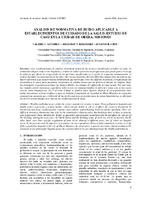Análisis de normativa de ruido aplicable a establecimientos de cuidado de la salud. estudio de caso en la ciudad de Oberá, Misiones
Date
2018-08-15Author
Sanabria, Valeria Viviana
Kolodziej, Sebastián Federico
Cruz, Eugenio Rubén
Metadata
Show full item recordAbstract
Los establecimientos de salud se encuentran dentro de los sectores considerados sensibles al ruido. La contaminación por ruido en los hospitales y centros de salud representa un peligro serio, que puede poner en riesgo la salud ya que afecta la recuperación de los pacientes interfiriendo en el sueño, la respuesta cardiovascular, el control del dolor, la cicatrización de heridas, entre otras cuestiones. Existen diferentes documentos normativos que hacen referencia a las características constructivas que tienen que tener los edificios en general, y en particular los destinados a la salud, para garantizar condiciones de calidad sonora que no afecten al interior del edificio. Entre las principales se pueden mencionar las Normas IRAM y los códigos de edificación de cada ciudad. Por otro lado,
las ciudades tienen normativas específicas sobre niveles de ruido permitidos en diferentes zonas, una de las cuales son las zonas hospitalarias. En el presente trabajo se plantea como objetivo analizar la correspondencia entre ambas normativas, a fin de verificar si para un hospital en particular de la ciudad de Oberá Misiones los requisitos constructivos aseguran que, en función de los niveles máximos permitidos para las zonas hospitalarias, se obtengan los niveles recomendados en el interior del establecimiento de salud. Health establishment are within the sectors considered sensitive to noise. Noise pollution in hospitals and health centers represents a serious danger, which can put health at risk as it affects the recovery of patients by interfering with sleep, cardiovascular response, pain control, wound healing, between another questions. There are different normative documents that refer to the constructive characteristics that buildings have to have in general, and in particular those intended for health, to guarantee sound quality conditions that do not affect the interior of the building. Among the main ones, the IRAM Norms and the building codes of each city can be mentioned. On the other hand, cities have specific regulations of noise levels allowed in different areas, one of which are hospital
areas. In the present work the objective is to analyze the correspondence between both regulations in order to verify if for a particular hospital in the city of Oberá Misiones the constructive requirements ensure that according to the maximum levels allowed for hospital areas, the recommended levels are obtained inside the health establishment.
Collections
The following license files are associated with this item:




